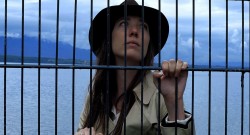Cinema | April 15th, 2015

Jean-Luc Godard, one of the pioneers of the French New Wave filmmaking movement in the late 1950s and early 1960s, is now in his 80s, but still making movies that are no less daring in “breaking the rules” of traditional cinematic techniques to express his ideas in new ways.
His “Adieu au langage” (“Goodbye to Language”) won him his first Jury Award at the Cannes Film Festival last year, and earlier this year it won the U.S. National Society of Film Critics Award for Best Picture. This week “Goodbye to Language” (2014) came out on Blu-ray from Kino.
As early as his first feature, “Breathless” (1960), Godard revolutionized approaches to editing by his extensive use of jump cuts as a consistent style, though their obviously mismatched and disjointed shots had previously been considered a mistake that broke the illusion of continuity and made it obvious you were watching a movie. Other early films continue his playful sense of life and fate with unusual use of cinematic techniques.
In “Farewell to Language,” Godard seems rather more reflective, yet nevertheless plays around with fresh, unusual and sometimes challenging uses of 3-D imagery and directional, multi-channel sound with a wide dynamic range from dead silence and near-silence to overbearingly loud.
These 21st century techniques become integrated into the simple story of two couples’ inability to communicate each other’s thoughts verbally and the calming effect of owning a dog. The narrative elements are still presented with the fragmentary editing style and frequently exaggerated or shifted colors that were a hallmark of 1960s experimental cinema, and which have since been worked into more mainstream movies.
In fact, much of the film calls to mind the abstract experimental works of Stan Brakhage, except there’s sound to accompany the images. Godard’s music underscoring continues his non-traditional style of cutting off or switching to something else when one would normally expect it to continue or fade out gradually. Sometimes his dialogue and sound effects also work independently of the image, which occasionally cuts to black while the audio continues or begins for the next scene.
As is typical with Godard films, there are numerous references to literature, art, cinema, philosophy and history, wordplay and puns, and a pervasive theme of alienation with an underlying critique of modern consumer-based (and now computer/technology-based) society. The plot, such as there is, follows two young couples who look very much alike, so much so that it may be hard to tell it’s not just one couple.
They go through their ups and downs and the banalities of everyday life. There’s also some sort of violent tragedy that occurs mostly off-screen and is possibly related to one of the couples, though the film never makes it clear. Dialogue is mostly in French (with optional English subtitles), plus some short sections in German and English (not subtitled).
Like many New Wave and independent films, the story material tends to be secondary to the technique and execution. The stereoscopic photography is almost hypnotic in its spectacular handling of depth. Watching the movie in its 2-D version may be less distracting for those trying to make sense of what little story there is (since the few independent right eye/left eye scenes show up as simple double-exposures in the 2-D cut), but the 3-D version is certainly the preferred way to view it, including the clever three-dimensional arrangement of the titles.
Kino’s Blu-ray release comes with two discs, one with the movie in 3-D and the other with a 2-D version along with a trailer and a 45-minute interview of Godard discussing the film and his work (both in HD). Picture and sound quality appear to reproduce the original intentions faithfully.
Portions of the movie were shot on crisp, high-definition cameras, other parts on inexpensive home camcorders, and portions have intentionally distorted color and sharpness. Audio likewise stretches the limits of volume from very quiet to very loud, sometimes natural-sounding, sometimes distorted, with the 5.1 track use also varying from natural stereo to extreme directional placement on one side or the other, or front or rear speakers.
The bonus feature of Godard, interviewed by someone from the Canon camera corporation, is interesting. But it also demonstrates how the director remains in his own little world with his own personal approach to things: his unorthodox way of finding a story without a script; being intentionally or unintentionally obscure in explaining his films’ deeper significance; and not always understanding the meanings behind certain filmmaking terms (such as “answer print”).
Also included is a 16-page illustrated pamphlet with an illuminating analysis by noted film professor David Bordwell.
“GOODBYE TO LANGUAGE” on Blu-ray – Movie: B / Video: A / 3D: A / Audio: A / Extras: B-
December 29th 2025
December 29th 2025
December 16th 2025
December 9th 2025
December 2nd 2025
__293px-wide.jpg)
__293px-wide.jpg)
_(1)_(1)_(1)__293px-wide.jpg)
_(1)__293px-wide.png)
_(1)__293px-wide.jpg)
_(1)__293px-wide.jpg)